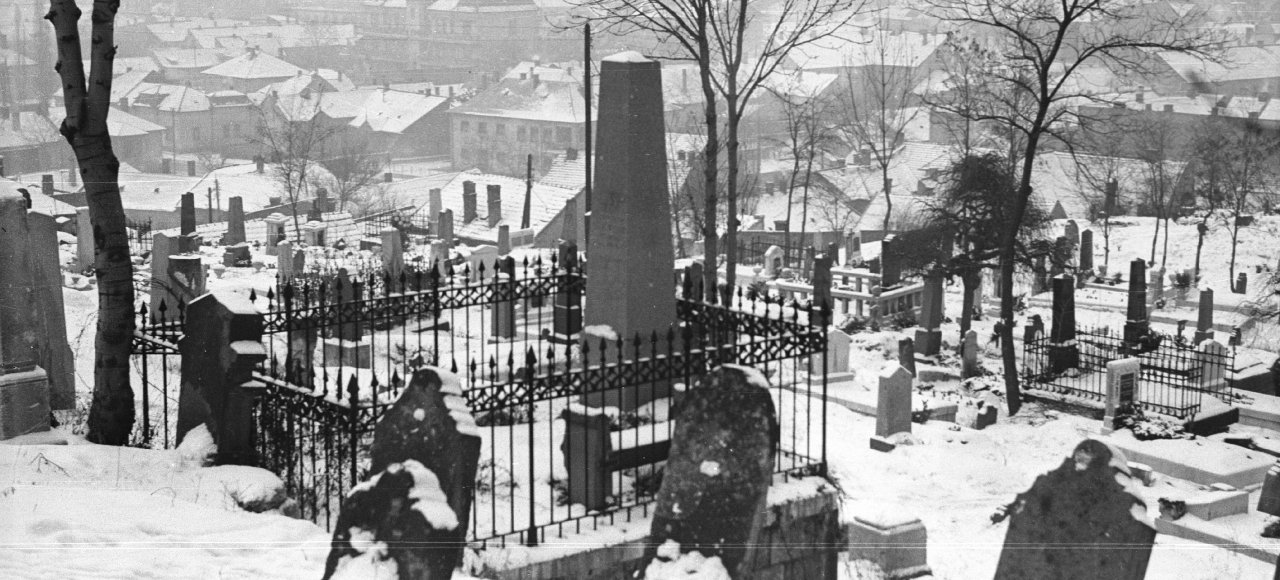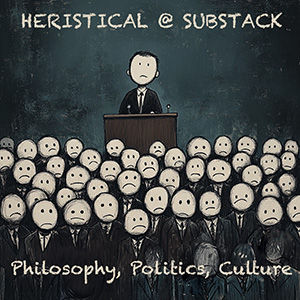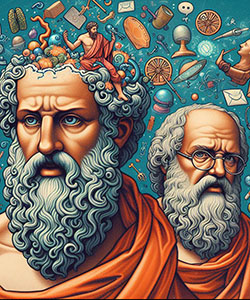
Spoiler Alert: This article contains revealing details about the novel’s (absurd) plot.
I have never felt about a book the way I feel about The Third Policeman by Flann O’Brien. Such strong feeling is often the preserve of the newly converted and yet I first read it about twelve years ago. The current crescendo in feeling is not easy to explain. I have a thought of the form < I wonder if such-and-such has read it—I should check—if not—maybe post it?> daily, and I have now bought the book for an unspecifiable number of people (I am at my most fervid when I have drink taken and I’d like to take this opportunity to apologise to the many victims of my missionary endeavours).
I think my obsession is best understood in terms of anxiety about my career in philosophy. I find a lot of philosophy difficult. I frequently have the unpleasant sensation of not understanding what other philosophers are talking about and that kind of professional confusion is stressful. For this reason, I’m particularly drawn to things that include the kind of elements that initially drew me to philosophy (puzzling, unwieldy conceptual detail, weird nomenclature, infinity) but that either aren’t styled as philosophy, or, particularly concerned with consistency, order, or any idea that there is a right way to understand them—basically, circumstances where you can enjoy the confusion.
O’Brien’s first novel, At Swim-Two-Birds, played a significant role in my reading history. At Swim is an important example of metafiction, a prose narrative that directs the reader’s attention toward the process of authorial composition. In At Swim, numerous plot lines and series of characters compete with one another for position in the text, which is itself about writing a novel. The result is a carnivalesque war between different levels of the narrative. When a friend gave me this book for my 18th birthday, I tried to read it and failed. I couldn’t follow it. My study of books in school had left me unable to read without scrambling desperately for plot-position and motifs. As a result, a panicky phenomenology accompanied reading that convinced me I had to reverse or pack it in when I overstepped a certain boundary of bewilderment. Never finding a way to do this with At Swim forced me to push on through the confusion. Ultimately, it did me a great service by loosening my grip on the narrative reins—allowing me to give up the fight for control and to read for the content at hand. When, a few years later, I finally made it all the way through At Swim on a beach somewhere, my public cackling surprised me.
The Third Policeman is staggeringly philosophical. It has so many elements to delight a philosophical reader that a good faith attempt to catalogue them would far outrun my small business here. So, with anxiety at the incompleteness of my sermon, here are three of my favourite elements.
Killing for the Canon
The opening of The Third Policeman is conspicuously pastoral and a strange introduction to the fantastical mélange which occupies the rest of the book. The main business of the first chapter is a murder, and it ends with a transition into another world. As O’Brien scholar Paul Eamonn Fagan has said, the opening “sets up genre expectations that it absolutely does not fulfil”. This parochial beginning acts as the frame for an incident that marks the transition into a wacky series of events that take place (unbeknownst to the narrator) after his own death.
Thus, we begin with murder. The nameless narrator collaborates in the killing of a local man and is then unwittingly murdered by his co-conspirator at the point of going to retrieve the cash-box spoils. The collaborator commits the murder(s) to get enough money to convince Pegeen Meers to marry him, or so he claims. Our narrator’s motives are quite different—he needs money to self-publish the canonical text on an eccentric philosopher named De Selby with an even more eccentric scholarship history. The narrator’s text, the ‘De Selby Index’, is the “definitive” collection “wherein the views of all known commentators on every aspect of the savant and his work [have] been collated.”
When, in Chapter 2, the narrator wakes up dead in his victim’s home, the whole scenario opens with a reflection on his hero De Selby’s bizarre housing philosophy:
De Selby has some interesting things to say on the subject of houses. A row of houses he regards as a row of necessary evils. The softening and degeneration of the human race he attributes to its progressive predilection for interiors and waning interest in the art of going out and staying there.
De Selby’s theoretical disdain is accompanied by practical solutions, including designs of preferable “habitats”, encompassing structures of two kinds—walls without roofs and roofs without walls. The novel integrates a variety of disquisitions on De Selby’s views relating to the experiences of the narrator. They surface in the main body of the text and in a series of detailed and fastidiously referenced footnotes which delve deep into the feuds between the big names in the apparently sordid history of the De Selby commentariat. My favourite such incident occurs at the beginning of Chapter 11 when the narrator is awaiting his own hanging and reflecting on “the immeasurable boon of sleep”.
The footnote is occasioned by the observation that De Selby was known to fall asleep mid-sentence. The next three pages are wholly absorbed by the continuation of this footnote, and it is difficult for a historian of philosophy not to be reminded of Pierre Bayle’s wonderful Historical and Critical Dictionary and its sprawling, book-swallowing footnotes. Of course, Bayle’s notes can scarcely be rivalled; an estimated 95% of the dictionary’s six million words are in footnotes, and there are even footnotes to footnotes. Though O’Brien’s notes never reach these levels of excess, they are terrifically funny (as indeed are some of Bayle’s).
In the long Chapter 11 footnote, the narrative begins with De Selby’s public sleeping incidents, moves to a discussion of his inability to distinguish men and women (including his description of a Countess Schnapper as “that cultured old gentleman” and “crafty old boy”), through to a discourse on the possible personal identity of the scholars known as “du Garbandier” and “the shadowy Kraus”. Many more hilarious incidents between De Selby scholars are outlined, and finally, perhaps as a nod to Bayle’s second-order footnotes, we receive a reading list of texts on the “undignified fate” of the scholar Hatchjaw, ranging from the definitive account of Henderson to a series of works that merely “repay study”. The parallel life of these erudite footnotes alongside the preposterous and confusing action of the main narrative is a heady mixture and may feel strangely familiar to a subset of readers of the history of philosophy.
Lists
Early in the narrator’s journey in the afterlife, he finds himself in the company of a man that frightens him. This man, Martin Finnucane, is revealed to be “the captain of the one-leggèd men in the country”, and ultimately a great ally of our (as it turns out) wooden-legged protagonist. At this point in the text, the narrator’s soul, “Joe”, is now speaking to him in an advisory capacity. Deciding that Finnucane is a “very slippery-looking customer”, Joe encourages the narrator to find out his name and occupation. The discourse starts as follows:
‘I do not desire to be inquisitive, sir,’ I said, ‘but would it be true to mention that you are a bird-catcher?’
‘Not a bird-catcher,’ he answered.
‘A tinker?’
‘Not that.’
‘A man on a journey?’
‘No, not that.’
‘A fiddler?’
‘Not that one.’
After some more back and forth, the same line of questioning is taken up again a page later:
‘Or a man out after rabbits?’ I asked.
‘Not that. Not that.’
‘A travelling man with a job of journey-work?’
‘No.’
‘Driving a steam thrashing-mill?’
‘Not for certain.’
‘Tin-plates?’
‘No.’
‘A town clerk?’
‘No.’
‘A water-works inspector?’
‘No.’
‘With pills for sick horses?’
‘Not with pills.’
‘Then by Dad,’ I remarked perplexedly, ‘your calling is very unusual and I cannot think of what it is at all, unless you are a farmer like myself, or a publican’s assistant or possibly something in the drapery line. Are you an actor or a mummer?’
‘Not them either.’
The Incongruity Theory of Humour tells us that humour is occasioned by violations of our expectations and cognitive patterns. The sheer randomness of the leaps across the plane of our expectations in O’Brien’s production of further possible jobs, varying from the mundane to the inherently silly, produces a hilarity that makes my heart vibrate. My favourite example of this kind of list-humour takes place in a conversation between the narrator and Sergeant Pluck in the police barracks that serve as the backdrop for the majority of the book’s strange antics. It is key to a few plot points that the narrator has no name. The Sergeant, keen to hang the narrator for a different murder is anxious to ascertain his name so that the paperwork will be in order (again, the clash between the bureaucratic and the absurd in this book is perfect). Pluck begins the disquisition:
‘Are you completely doubtless that you are nameless?’ he asked.
‘Positively certain.’
‘Would it be Mick Barry?’
‘No.’
‘Charlemagne O’Keeffe?’
‘No.’
‘Sir Justin Sens?’
‘Not that.’
‘Kimberley?’
‘No.’
‘Bernard Fann?’
‘No.’
‘Joseph Poe or Nolan?’
‘No.’
‘One of the Garvins of or the Moynihans?’
‘Not them.’
‘Rosencranz O’Dowd?’
‘No.’
‘Would it be O’Benson?’
‘Not O’Benson.’
‘The Quigleys, the Mulrooneys or the Hounimen?’
‘No’
‘The Hardimen or the Merrimen?’
‘Not them,’
‘Peter Dundy?’
‘No.’
‘Scrutch?’
‘No.’
‘Lord Brad?’
‘Not him.’
‘The O’Growneys, the O’Roartys or the Finnehys?
‘No.’
‘This is an amazing piece of denial and denunciation’ he said (…) ‘An astonishing parade of nullity’; he added.
O’Brien establishes a witty rhythm of conspicuously Irish names occasionally punctuated by lofty ones (Charlemagne, Rosencrantz, a Sir and a Lord). The intervention, then, of the ridiculous “Scrutch” reduces me to tears. That minute disruption of recently built expectations explains the Incongruity Theory nicely. The humour of this exchange is only enhanced by the awareness that the author himself wrote under a variety of pseudonyms—the novels are by Flann O’Brien, his Irish Times column was by Myles na gCopaleen. His real name was Brian O’Nolan/Brian Ó’Nualláin, but at other times he entertained pseudonyms as magisterial as Velvet Texture. The strange rhythms of the dialogues in the text, whether it’s rapid-fire lists as above or more convoluted and baffling exchanges like those between the narrator and policeman MacCruiskeen, are among its finest points.
Horrifying Abstractions
Another of O’Brien’s gifts is the production of horrors from abstraction. Adherents of the tradition (primarily of eighteenth-century philosophy) called “common-sense philosophy” understood themselves as pushing back against the speculative and theoretical excesses in much philosophy of the period. George Berkeley fits weirdly in this tradition. On the one hand, he was then and has since been regarded as the purveyor of an eccentric and counterintuitive metaphysics—it was a key target of the canonical advocacy of common-sense philosophy in Thomas Reid’s Inquiry Into the Human Mind on the Principles of Common Sense (1764). On the other, Berkeley preached a common-sense manifesto himself and believed his idealism represented the views of the ordinary person, uncorrupted by scholastic learning or Newtonian corpuscularianism.
Berkeley certainly invoked common sense when criticizing the increasingly abstract mathematics of his contemporaries. This was the period when mathematics involving infinites really came to the fore, and Berkeley’s commitment to the primacy of the world of experience meant that he was bewildered by the general public esteem of many abstract creations of the scientific and mathematical revolutions. To him, these mathematical excesses were all strange extrapolations from reality and the fact that people worshipped mathematics as the most venerable kind of reasoning was like the whole world becoming devoted to a strange kind of jigsaw-puzzling. In his famous critique of calculus, The Analyst (1734), he referred to fundamental parts of Newton’s theories as “the ghosts of departed quantities”, because, to his mind, Newton was trying to have his cake and eat it too by postulating entities that seemed to Berkeley to be simultaneously equal to and not equal tozero—existing and not-existing.
This language of “ghosts of departed quantities” always returns to me when re-reading The Third Policeman, because, in many ways, the book can be read as a kind of allegory for common sense. O’Brien produces uncanny horrors from speculative and theoretical elements of the text, and his deft use of the impossibly small is just one example.
One of the key characters, policeman MacCruiskeen is very interested in tiny projects. When we first encounter MacCruiskeen, he is in the kitchen of the barracks, and keen to show our narrator some of his feats of engineering. After gently stabbing him with a spear with an invisible tip he has honed, he shows him a chest he has made:
He walked back to the dresser, opened the lower part of it, and took out a little chest till he put it on the table for my inspection. Never in my life did I inspect anything more ornamental and well-made. It was a brown chest like those owned by sea-faring men or lascars from Singapore, but it was diminutive in a very perfect way as if you were looking at a full-size one through the wrong end of a spy-glass. It was about a foot in height, perfect in its proportions and without fault in workmanship. There were indents and carving and fanciful excoriations and designs on every side of it and there was a bend on the lid that gave the article great distinction. At every corner there was a shiny brass corner-piece and on the lid there were brass corner-pieces beautifully wrought and curved impeccably against the wood. The whole thing had the dignity and the satisfying quality of true art.
The chest is so beautiful the narrator finds it “nearly too nice (…) to talk about it” and “unmentionable”. When he opens the box, he learns that Mac Cruiskeen decided that the only thing he could bear to put in it—that wasn’t “contrary to the spirit of the chest”—was “another chest of the same make but littler in cubic dimension.” When he produces the internal chest, the narrator describes its delightfulness as having “interfered with [his] breathing”. The narrator then sits down to observe as, using teaspoon handles and then tiny knives, MacCruiskeen reveals ten further Matryoshka chests, each nested in the previous. Eventually, with the assistance of a borrowed pin, he extracts more chests until there are thirty-one of these Mandelbrotian creations, the last few of which are invisible. The production of the final two chests from their predecessors is clearly upsetting to the narrator:
He took a something from his pocket that was too small for me to see and started working with the tiny black thing on the table beside the bigger thing which was itself too small to be described.
At this point I became afraid. What he was doing was no longer wonderful but terrible.
I struggle not to think of the narrator as a horrified Leopold Kronecker recoiling at what he regarded as Cantor’s deformation of the mathematical landscape with his “youth-corrupting” non-denumerable infinities.
‘Six years ago they began to get invisible, glass or no glass. Nobody has ever seen the last five I made because no glass is strong enough to make them big enough to be regarded truly as the smallest things ever made. Nobody can see me making them because my little tools are invisible into the same bargain. The one I am making now is nearly as small as nothing. Number One would hold a million of them at the same time and there would be room left for a pair of woman’s horse-breeches if they were rolled up.’
In the same page he describes the inaudible products of a “small piano-instrument” he has invented in the following terms: “the vibrations of the true notes are so high in their fine frequencies that they cannot be appreciated by the human earcup.” In a later scene, another barracks character, Michael Gilhaney, unwittingly knocks the smallest chest out of MacCruiskeen’s hands during a clumsy fall. MacCruiskeen—incensed—takes out a pistol and demands they search the floor until they find it. Finally, the narrator reflects on his sad fate hunting at gunpoint for an invisible, intangible object, and I am reminded of early calculus’s existing-and-non-existing “ghosts”:
We crawled feebly about the floor, peering and feeling for something that could not be felt or seen and that was really too small to be lost.
To conclude: the dangers of over-enthusiastic book promotion are not lost on me. There is, among readerly women, a trope of the ‘Foster-Wallace-fanboy’—a man so wholly devoted to the promotion of Infinite Jest that he regards not having read it as a form of life that cannot be allowed to continue. Despite understanding the likely relationship between this literary zealotry and my not having read any Wallace, my commitment to my own book Evangelism project grows daily. Someone once said “[e]verybody is identical in their secret unspoken belief that way deep down they are different from everyone else.” Well, like all Evangelists worth their salt, I know my cause is true. So, between its vanishingly small monstrosities, its hilarious lists and truly anarchic take on the scholarly life, The Third Policeman is the perfect philosophical novel and you must read it.
Amen.
Clare Moriarty is an Irish Research Council Postdoctoral Fellow working in the Philosophy Department at Trinity College Dublin. Her research typically focuses on issues at the intersection of philosophy and mathematics, often in the early modern period.

